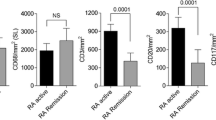Abstract
We compared histologic, immunohistochemical, and vascular findings in synovial biopsies from individuals with Gulf War Veterans Illness and joint pain (GWVI) to findings in normal and osteoarthritis (OA) synovium. The following parameters were assessed in synovial biopsies from ten individuals with GWVI: lining thickness, histologic synovitis score, and vascular density in hematoxylin & eosin-stained sections; and CD68+ lining surface cells and CD15+, CD3+, CD8+, CD20+, CD38+, CD68+, and Ki-67+ subintimal cells and von Willebrand Factor+ vessels immunohistochemically. Comparisons were made to synovial specimens from healthy volunteers (n = 10) and patients with OA or RA (n = 25 each). Histologic appearance and quantitative assessments were nearly identical in the GWVI and normal specimens. Vascular density was between 25% (H & E stains; p = 0.003) and 31% (vWF immunostains; p = 0.02) lower in GWVI and normal specimens than in OA. CD68+ macrophages were the most common inflammatory cells in GWVI (45.3 ± 10.1 SEM cells/mm2) and normal synovium (45.6 ± 7.4) followed by CD3+ T cells (GWVI, 15.1 ± 6.3; normal, 27.1 ± 9.2), whereas there were practically no CD20+, CD38+, and CD15+ cells. All parameters except lining thickness and CD15 and CD20 expression were significantly higher in OA. Five (20%) OA specimens contained significant fractions of humoral immune cells in mononuclear infiltrates, although the overall differences in the relative composition of the OA mononuclear infiltrates did not reach statistical significance compared to GWVI and normal synovium. In summary, the GWVI and normal synovia were indistinguishable from each other and contained similar low-grade inflammatory cell populations consisting almost entirely of macrophages and T cells.


Similar content being viewed by others
References
Hodgson MJ, Kipen HM (1999) Gulf War illnesses: causation and treatment. J Occup Environ Med 41(6):443–452
Grady EP, Carpenter MT, Koenig CD, Older SA, Battafarano DF (1998) Rheumatic findings in Gulf War veterans. Arch Intern Med 158(4):367–371
Health Effects of Serving in the Gulf War (2006) Washington, D.C.: The National Academies Press
Peakman M, Skowera A, Hotopf M (2006) Immunological dysfunction, vaccination and Gulf War illness. Philos Trans R Soc Lond B Biol Sci 361(1468):681–687
Diaz-Torne C, Schumacher HR, Yu X, Gomez-Vaquero C, Dai L, Chen LX et al (2007) Absence of histologic evidence of synovitis in patients with Gulf War veterans’ illness with joint pain. Arthritis Rheum (Arthr Care Res) 57(7):1316–1323
Escalante A, Fischbach M (1998) Musculoskeletal manifestations, pain, and quality of life in Persian Gulf War veterans referred for rheumatologic evaluation. J Rheumatol 25(11):2228–2235
Donta ST, Engel CC Jr., Collins JF, Baseman JB, Dever LL, Taylor T et al (2004) Benefits and harms of doxycycline treatment for Gulf War veterans’ illnesses: a randomized, double-blind, placebo-controlled trial. Ann Intern Med 141(2):85–94
Schumacher HR (2001) Synovial fluid analysis and synovial biopsy. In: Kelley WN (ed) Kelley's textbook of rheumatology. 6th edn. Philadelphia, Saunders, pp 605–619
Singh JA, Arayssi T, Duray P, Schumacher HR (2004) Immunohistochemistry of normal human knee synovium: a quantitative study. Ann Rheum Dis 63(7):785–790
Krenn V, Morawietz L, Burmester GR, Kinne RW, Mueller-Ladner U, Muller B et al (2006) Synovitis score: discrimination between chronic low-grade and high-grade synovitis. Histopathology 49(4):358–364
Krenn V, Morawietz L, Häupl T, Neidel J, Petersen I, König A (2002) Grading of chronic synovitis—a histopathological grading system for molecular and diagnostic pathology. Pathol Res Pract 198(5):317–325
Pessler F, Ogdie A, Diaz-Torne C, Dai L, Yu X, Einhorn E et al (2008) Subintimal Ki-67 as a synovial tissue biomarker for inflammatory arthropathies. Ann Rheum Dis 67(2):162–167
Krenn V, Morawietz L, Burmester GR, Häupl T (2005) Synovialitis score: histopathological grading system for chronic rheumatic and non-rheumatic synovialitis. Z Rheumatol 64(5):334–342
Maruotti N, Cantatore FP, Crivellato E, Vacca A, Ribatti D (2006) Angiogenesis in rheumatoid arthritis. Histol Histopathol 21(5):557–566
Leong TT, Fearon U, Veale DJ (2005) Angiogenesis in psoriasis and psoriatic arthritis: clues to disease pathogenesis. Curr Rheumatol Rep 7(4):325–329
Bonnet CS, Walsh DA (2005) Osteoarthritis, angiogenesis and inflammation. Rheumatology (Oxford) 44(1):7–16
Pessler F, Dai L, Diaz-Torne D, Gomez-Vaquero C, Paessler ME, Zheng DH et al (2008) The synovitis of “non-inflammatory” orthopedic arthropathies: a quantitative histologic and immunohistochemical analysis. Ann Rheum Dis (in press) DOI 10.1136/ard.2008.087775
Oehler S, Neureiter D, Meyer-Scholten C, Aigner T (2002) Subtyping of osteoarthritic synoviopathy. Clin Exp Rheumatol 20(5):633–640
Da RR, Qin Y, Baeten D, Zhang Y (2007) B cell clonal expansion and somatic hypermutation of Ig variable heavy chain genes in the synovial membrane of patients with osteoarthritis. J Immunol 178(1):557–565
Acknowledgments
We thank Gilda Clayburne for expert technical assistance, Irene Loglisci, Roxann Thompson, Valice Matthews, and John Romano (Philadelphia VA Medical Center, Department of Pathology) for help with histology, Alexis Ogdie (University of Pennsylvania School of Medicine) for assistance with data management, and Jasvinder Singh (University of Minnesota, Div. of Rheumatology) for helpful discussion and critical reading of the manuscript. F. Pessler was supported by National Institutes of Health Training Grants T32-AR 007442 and T32-CA 09140 and a 2007-8 American College of Rheumatology/Research and Education Foundation Amgen Pediatric Rheumatology Research Award.
Conflict of interest statement
None.
Author information
Authors and Affiliations
Corresponding author
Rights and permissions
About this article
Cite this article
Pessler, F., Chen, L.X., Dai, L. et al. A histomorphometric analysis of synovial biopsies from individuals with Gulf War Veterans’ Illness and joint pain compared to normal and osteoarthritis synovium. Clin Rheumatol 27, 1127–1134 (2008). https://doi.org/10.1007/s10067-008-0878-0
Received:
Revised:
Accepted:
Published:
Issue Date:
DOI: https://doi.org/10.1007/s10067-008-0878-0




